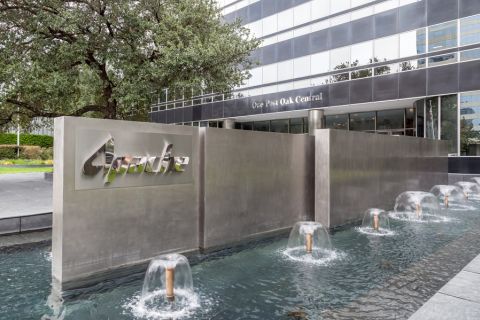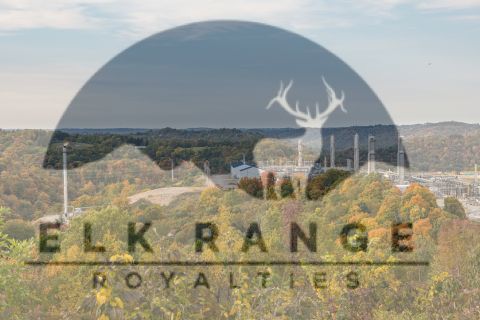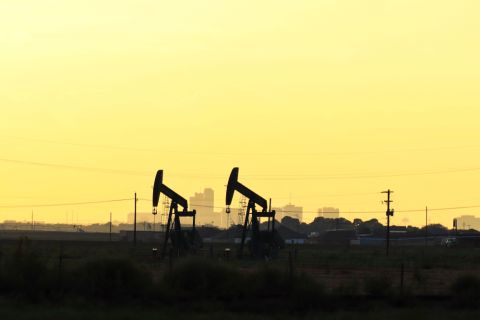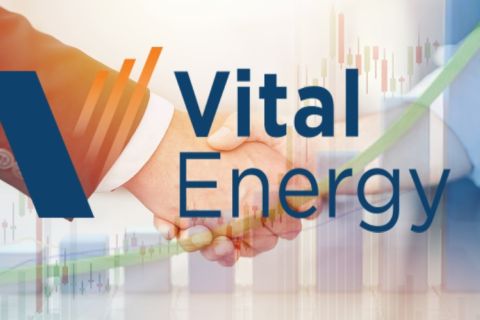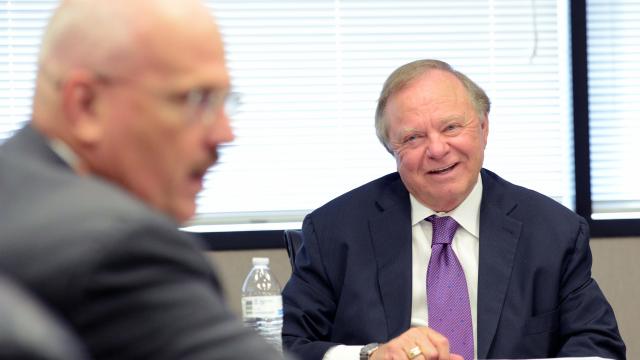
Harold Hamm, right, chairman and CEO of Continental Resources Inc., spoke at length with Hart Energy's Paul Hart, editor in chief of Midstream Business, and Leslie Haines (not pictured), executive editor at large of Oil and Gas Investor. (Source: Hart Energy)
Sales abroad of crude oil, natural gas and petroleum products have reached more than 7 million barrels of oil equivalent per day (MMboe/d), representing a new industry for the U.S., according to Harold Hamm, who heads one of the nation’s largest independent oil and gas producers.
Crude oil exports alone may increase to 4 MMbbl/d by 2022, according to recent remarks by Enterprise Products Partners LP, as the world demands more light sweet crude. China has gone from taking just one cargo of under 1 MMbbl in the first eight months of 2016 to buying about 115,000 bbl/d from the U.S. so far this year, according to Reuters.
The problem is, the nation simply is not equipped to handle the potential outflow after a 40-year federal law that prohibited most crude sales abroad. The nation’s excellent midstream infrastructure was directed to bringing in and distributing oil supplies—not sending them out.
The shale revolution changed that. The U.S. has re-emerged as a major crude oil and natural gas trader on the world’s energy stage.
New infrastructure must go in place to transport and/or liquefy the gas and load tankers—many of which are so large they can’t enter U.S. ports—if the U.S. expects to reach its potential. Since Hamm has been a strong proponent of energy exports, the editors of Midstream Business and its sister publication, Oil & Gas Investor, met with him at his Oklahoma City headquarters recently to discuss the potential and challenges he sees in fulfilling that promise.
In addition, he explained why his team takes issue with the U.S. Energy Information Administration’s (EIA) data and projections, upon which so many securities analysts, and the industry itself, rely. He thinks the EIA’s errors are causing a lot of misperceptions about the global oil glut and charges that it’s caused by U.S. producers.
Hamm: EIA's Forecasts Costly To Industry
MIDSTREAM Why are crude exports so important to U.S. producers?
HAMM We can’t control the market, so, through contractual arrangements or otherwise, oil and gas companies are quickly changing what they do and how they do it. We’ve brought in people to do that and we’re not the only ones. Thirty percent of U.S. oil production could be going to foreign countries soon. It would be “game over” if the U.S. couldn’t sell that oil, that’s the name of the game.
The current amount of exports is important; over 6 million barrels per day of crude and petroleum products are now being exported. This is new and additional business for the midstream and, as I’ve said, it’s a new industry for America. We said it would spawn a whole new industry and it has; a lot of new companies have sprung up. It’s a little bit hard on our infrastructure because this is going all around the world.
The first product shipments were going to South America, but there are a lot of shipments of crude and products now going all over. China is a big market: They have a lot of these small—I call them “teapot”—refineries, but some of them run 160,000 barrels per day, which is not that small. They were required to use domestic crude supply, but now they can deal directly with anybody and buy supply from anywhere—and they want to diversify their supply. The Chinese are coming here to talk.
They (China) need our light sweet crude. A lot of foreign refineries were built—and are operated—on the cheap. They are not complex and can’t run heavy and sour crudes. We’ve found there are a lot of refineries that want light shale oil; there’s a good market for it.
Enterprise Products (Partners LP) and my friend (Enterprise CEO) Jim Teague and other midstream operators have done very well with (crude oil) exports. One of the first shipments—in January 2016—was done by Enterprise.
MIDSTREAM You recently projected that U.S. LNG exports will roughly triple in the long term and take around 40% of domestic gas production. Given increasing LNG output by Australia and other suppliers, is there a sufficient worldwide market for such large volumes?
HAMM There is. The short answer is there are a lot of LNG markets and not always where you expect. There is a lot of interest even in the Middle East, in Dubai, for example, in U.S.-produced LNG. The Mideast producers have drilled for gas, thinking there would be a lot produced, but really not much has been found. And what they found has been sour natural gas, so they haven’t had much success with it. It’s tremendously sour.
We’ve seen LNG exports rise to between 2.5- and 3 billion cubic feet (Bcf) per day and it could grow to 10 or 11 Bcf per day by 2019. We’re off to an awfully good start. There are 143 to 147 receiving points around the world and there will be more, so it’s a big market. It’s a lot easier to build receiving terminals than liquefaction plants. It is absolutely a good growth industry for us.
And can we compete with Australia and Qatar? Yes, I absolutely think we can. We have the infrastructure and we can be the low-cost producer.
MIDSTREAM What about Mexico? Will the U.S. continue to increase its exported gas volumes across the border in the foreseeable future?
HAMM Mexico has been a very good market; let’s face it, natural gas is cheap and very accessible to them. People thought it would be about a 5-Bcf-per-day market, but it’s going way past that. Some people have forecasted that it will go higher. A lot of times, forecasts and predictions are wrong.
MIDSTREAM How have crude exports affected Continental?
HAMM It, obviously, ultimately impacts us, but we leave the sales to the midstream players—to Koch (Industries Inc.), Enterprise Products and others. But it benefits us in a lot of ways: Instead of worrying about outlets for our crude, we’re working at capacity and we’re not going to be at the mercy of U.S. refiners—I never want to be in that position again. We’re not going to do that anymore.
The balance has shifted. We did have something of an adverse relationship with refiners before the export ban was lifted. Some of them actually fought to keep it, but the big refiners—like ExxonMobil, Chevron and Phillips [66]—were supportive. Others want to keep domestic producers as their milk cow and we do not want to do that.
It’s important to remember that a large share of U.S. refining capacity—about 30%—is owned by foreign crude producers, who bought plants and modified them to run their specific crudes. They aren’t interested in U.S. crude production being exported.
MIDSTREAM Has the export market for U.S. crude grown as rapidly as you expected, following the lifting of the export ban at the end of 2015?
HAMM It has. Lifting the ban had two effects. First, within 11 hours, the differential between West Texas Intermediate [WTI] and Brent went to zero, but it (Brent) has gone back up. Two, the market has grown since then to about all the exports we can handle with the infrastructure that we have. We really need to be able to load those very large ships. A couple of things have helped. One was expansion of the Panama Canal. The other is the expansion of our ability to load tankers for export at our ports.
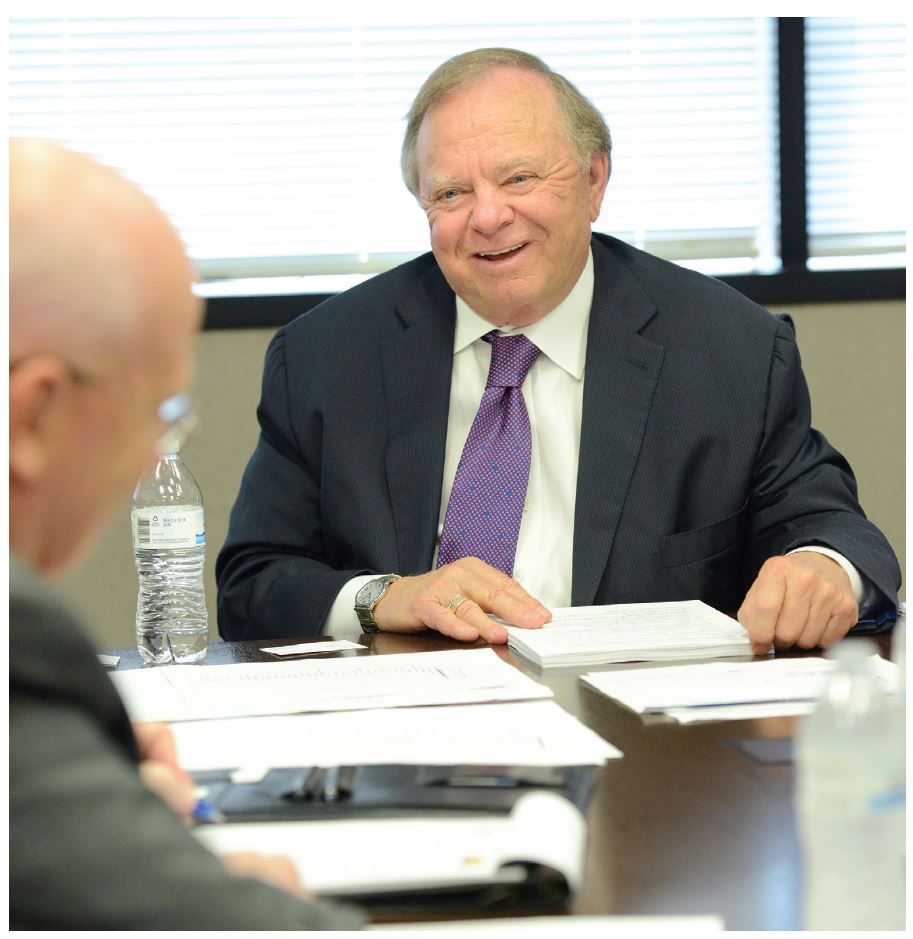
MIDSTREAM Have you heard from overseas crude customers that buy U.S. oil? What are their thoughts?
HAMM We have had early contacts with some of them. We talk with South Korea all the time. They were buying oil from Iran and some other people they really didn’t want to deal with. They wanted to change that permanently and quickly. They want deals that are dependable; they’re following the lead of China.
MIDSTREAM Can the U.S. gain markets by proving itself a dependable source—in comparison with Venezuela and other politically unstable countries?
HAMM I’ve said all along that the United States can be the producer of choice. We are dependable, and we have the banks, the rule of law and the courts; contracts matter, if there are questions. It’s quick and easy to do business with us. We knew we’d become the market of choice and we’re seeing that play out.
MIDSTREAM How does the midstream need to change to support swelling exports? Do you feel it is responding adequately?
HAMM I believe the midstream is responding, but it will take a little while to get moving. Take a look at Corpus Christi, Texas. I read that there will be $30 billion invested to make that port ready to handle growing exports. Corpus is a very important port and it’s important to be there, yet Corpus can’t handle the really big ships—the VLCCs [very large crude carriers]—but that will change going forward. That’s a lot of money; we’re talking about what it would cost to build a large refinery. But this type of infrastructure is huge and it will have to be there—given the magnitude of this business.
Also, the LOOP [Louisiana Offshore Oil Port] is an example of infrastructure that needs to be changed. It can already handle incoming VLCCs that want to unload. [Editor’s note: The facility recently announced plans to make upgrades that will allow it to load, as well as unload, tankers starting in early 2018.]
MIDSTREAM What impact has the Dakota Access Pipeline (DAPL) had on Continental and other Bakken producers?
HAMM Things have improved recently since DAPL has gone into service. You can’t blame the midstream if they couldn’t get it done—with all of the opposition.
Actually, it’s had a large impact on transportation costs as the differential for Bakken crude has gone down below $2.50 per barrel compared to WTI. It has taken Bakken oil off the tracks, which was very expensive. We needed the infrastructure and now we have it. We had to use rail for some time and that added as much as $12 per barrel in transportation costs.
MIDSTREAM What about your Oklahoma production? Where is it going and is any of it exported?
HAMM We are so close to the Cushing, Okla., terminal that most of it goes there. Some of it goes to the CVR Refining [LP] plant at Wynnewood, Okla. It is not a complex refinery and the light, sweet crude we produce fits it well.
MIDSTREAM You recently said that, overall, domestic producers need crude prices at $50 per barrel or higher to be consistently profitable. Will exports help meet that goal?
HAMM They will, but there’s quite a bit of variance. The impact of exports can be great. There may be a lot of supply now, but that’s not sustainable worldwide at lower prices. Producers are incapable of sustaining production without adequate capex and the EBITDA to support it and we have to have that to generate a return for our investors. There’s one inescapable fact: The lower the price is, the less revenue you have and the less capex you have, and then you can’t meet the world demand.
MIDSTREAM What kind of price does Continental need to break even in the Bakken and Oklahoma’s Scoop and Stack plays?
HAMM Well, first, let’s talk about the Bakken. This is the best pure oil play in America. We needed the infrastructure and now we have it. We also needed the technology, such as multistage completions, and now we have that. For most of us in the core of the play, we need at least $40 per barrel to break even with some kind of decent margin. It’s good that Continental is the low-cost producer with lower lifting costs up there. We’ve had to drive out about $3.50 per barrel in costs to remain competitive.
For the Scoop and Stack, these are awfully good plays. We can make money below $50 per barrel—maybe less than $40—but that results in low capex. The existing infrastructure makes a lot of difference for sure. Prices below $50 are unsustainable.

MIDSTREAM You announced a joint venture with South Korea’s SK E&S Co. Ltd. in 2014 for some of your Cana Woodford acreage in the Midcontinent. Is your partner taking that gas as LNG? Do you expect the relationship to grow?
HAMM They made a large investment in the play but SK has not taken any LNG up to this point—but they could. It has been a good business relationship for us.
MIDSTREAM You told the Financial Times that Continental is “an opportunistic entity: We’re not devoted only to oil.” Do you plan to increase your production of gas, relative to oil?
HAMM We produce a lot of oil—about 60% of our production. In the second quarter, it was 56% and I expect it to be 60% or greater for the balance of this year, given about where we run right now on the oil cut. We produce a lot of gas when you look at Scoop and Stack wells that produce 1,000 to 1,500 barrels of oil equivalent per day.
Paul Hart can be reached at pdhart@hartenergy.com or 713-260-6427. Leslie Haines can be reached at lhaines@hartenergy.com or 713-260-6428.
Recommended Reading
APA Closes $4.5B Callon Deal, Deepening Permian Roots
2024-04-01 - About two-thirds of Apache’s daily production will come from the Permian Basin after APA Corp. completed its $4.5 billion takeout of Callon Petroleum.
Elk Range Royalties Makes Entry in Appalachia with Three-state Deal
2024-03-28 - NGP-backed Elk Range Royalties signed its first deal for mineral and royalty interests in Appalachia, including locations in Pennsylvania, Ohio and West Virginia.
Dallas Fed Energy Survey: Permian Basin Breakeven Costs Moving Up
2024-03-28 - Breakeven costs in America’s hottest oil play continue to rise, but crude producers are still making money, according to the first-quarter Dallas Fed Energy Survey. The situation is more dire for natural gas producers.
Marketed: EnCore Permian Holdings 17 Asset Packages
2024-03-05 - EnCore Permian Holdings LP has retained EnergyNet for the sale of 17 asset packages available on EnergyNet's platform.
Vital Energy's ‘Wildly Successful’ 2023 ‘Small Ball’ M&A Now in ‘Moneyball’ Mode
2024-02-23 - The operator added big runs in $1.6 billion of 2023 deals. Now Vital is looking to make more out of its hits via geology and geophysics, including steals “for free.” Still, it might pick up big consolidators’ cast-offs.

